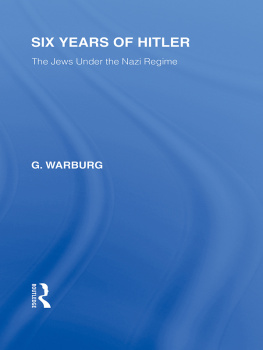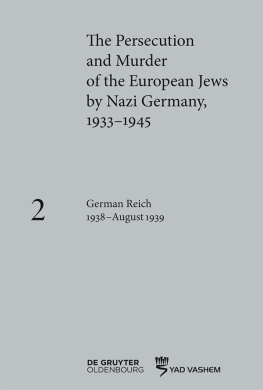The Jews in the Secret Nazi
Reports on Popular Opinion
in Germany, 19331945
Edited by Otto Dov Kulka and Eberhard Jckel
Translated from the German by William Templer
English edition prepared with the assistance of
Corinna Kaiser and Irene Aue
Yale UNIVERSITY PRESS
New Haven and London
Published with assistance from the foundation established in memory of Calvin Chapin of the Class of 1788, Yale College.
Copyright 2010 by Yale University.
All rights reserved.
This book may not be reproduced, in whole or in part, including illustrations, in any form (beyond that copying permitted by Sections 107 and 108 of the U.S. Copyright Law and except by reviewers for the public press), without written permission from the publishers.
First published as Die Juden in den geheimen NS-Stimmungsberichten 19331945 2004 Droste Verlag GmbH Dusseldorf.
Yale University Press books may be purchased in quantity for educational, business, or promotional use. For information, please e-mail sales.press@yale.edu (U.S. office) or sales@yaleup.co.uk (U.K. office).
Designed by Lindsey Voskowsky. Set in Minion type by Keystone Typesetting, Inc., Orwigsburg, Pennsylvania. Printed in the United States of America.
Library of Congress Control Number: 2009941898
ISBN 978-0-300-11803-2
A catalogue record for this book is available from the British Library.
This paper meets the requirements of ANSI/NISO Z39.48-1992 (Permanence of Paper).
10 9 8 7 6 5 4 3 2 1
Contents
Illustrations
Preface
What were the attitudes of the German population to the persecution of the Jews under the Nazi regime and what part did they have in it?
What did they know about the annihilation of the Jews and how did they view it?
What were the everyday life and organized activities of the Jews like in Germany during this period and how were they reflected in reports to the regime?
The unique source material represented by the secret Nazi reports on popular opinion makes it possible to investigate these open questions. A joint research project of The Hebrew University of Jerusalem and the University of Stuttgart in Germany was able to amass the still extant and widely scattered source materials from archives in Germany and other countries, working over several years to complete this demanding and difficult task. In 2004 these materials were published in book form with an accompanying supplementary CD-ROM as Die Juden in den geheimen NS-Stimmungsberichten 19331945, edited by Otto Dov Kulka and Eberhard Jckel (Dsseldorf: Droste Verlag, 2004, Schriften des Bundesarchivs 62). The book is henceforth referred to as Stimmungsberichte. This German edition was already amply enriched by explanations in the form of copious notes and an array of auxiliary scholarly tools, and was thus made accessible to a wider readership beyond the circle of professional historians. In preparing this English edition, the editors carefully revised and reworked the entire book with an eye to creating an edition for an English-speaking international public.
As for the German edition of the book, the editors selected and translated 752 documents and arranged them in fourteen thematically and chronologically structured chapters that allow the reader to follow the multifaceted and disastrous course of events as they unfolded. The complete digitalized corpus of 3,744 documents on CD-ROM affords researchers almost unlimited possibilities for further investigation thanks to its sophisticated search engine. The CD-ROM, in the original German language, with an optional English menu, accompanies the book. The new extended introduction to the book presents in its first part an updated overview covering source editions and the research literature; its second part is completely new and provides, in an exemplary form, various findings arrived at on the basis of this special corpus of source materials. In addition, all the footnotes were carefully checked, and wherever possible works cited in German were replaced by reference to their English-language editions. This is also reflected in the new, revised Bibliography. To make the edition more accessible to an English-speaking readership, new footnotes were added, the Historical Glossary was supplemented by a number of new entries, and existing entries were revised. The Chronology was also reworked along similar lines.
The list of documents was supplemented by a Concordance for each document in this English edition that gives the corresponding document in the far more extensive CD-ROM edition in German. This was considered to be helpful because in research literature the reader will often find references to document numbers of the CD-ROM and not the book. The connection between these two modes of presentation is explained in detail in the Notes to the Reader.
Such an extensive translation project is demanding and represents a substantial challenge for both the translator and the editors. The reports in the documents were written by many individuals who came from very different backgrounds. They included members of the SD, some of whom had a high level of academic and ideological training, as well as village police officers, who did not always have perfect command of standard written German. An attempt has been made here to retain the individual character of these reports to the extent that this seems appropriate in a translation of this type. A seemingly clumsy text is thus not the sign of a poor translation, but rather the contrary. At the same time, great effort was made to ensure strict terminological uniformity throughout the entire text corpus in English translation, while utilizing terms and concepts familiar to an English-speaking readership. In some cases, it was decided to retain the original German term. That was done, for example, for the central concept in Nazi ideology of the Volk and its derivatives, such as the Volksgemeinschaft (racial community) or the adjective vlkisch, for which there are no readily accepted English equivalents.
These terms and concepts, marked in boldface in the document texts, are explained in the Historical Glossary. Likewise, the names for certain organizations were also retained in the German original (such as Gestapo, SS, SD). In the case of abbreviations, such as SS or SD, they are given in full in the List of Abbreviations. In addition, when marked boldface, they are explained in the Historical Glossary along with a description of their organizational structure. In a few instances, a translation was used that may initially strike the English-speaking reader as somewhat unexpected. One such example is the term Jewish Gemeinde (community). Since the German-Jewish Gemeinden are not comparable to the British, Canadian, or American Jewish congregations in their organizational form and self-conception, the term Jewish Community was intentionally chosen as the best equivalent. In such cases as well, the glossary explains the concept and refers to relevant literature.
The translator, William Templer, played a key role in this endeavor. An experienced expert on translating texts dealing with German-Jewish history and the history of National Socialism, he also gave valuable suggestions for the English-language Bibliography and for expanding a number of the entries in the Glossary, especially those connected with the American-Jewish context. Our cooperative endeavors extended at times over three continents, and yet were always marked by excellence and precision. We owe him a special expression of lasting gratitude.
The holdings of the Federal German Archives (Bundesarchiv) served as the point of departure for gathering the materials. Consequently, the German edition was published as a part of its publication series








